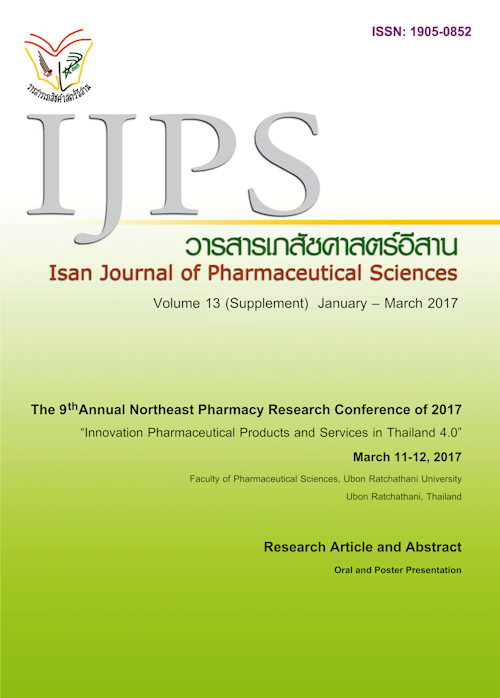Rate of Drug Interaction from Overriding Automatic Drug Interaction Warning System and from Different Prescriptions
Main Article Content
Abstract
Introduction :Although drug interaction (DI) pop-up was alert from automatic drug interactions warning system in the prescribing process, it can be overridden by the prescribers. In addition, it cannot detect DI from different prescriptions. The objectives of this study were to measure DIs with major and moderate severity in the same prescription and to identify DIs with major severity from different prescriptions. Methods: Out patient prescriptions from January 1 to December 2015 were searched for DIs from the same prescription and different prescriptions. Drug Interaction Facts® 2009 was used as a reference to identify and classify DIs with major and moderate severity. Data were analyzed by descriptive statistics. Results: Among 173,746 prescriptions, major and moderate severity DIs from the same prescription were observed in 1,379 (7.94 episodes/per 1,000 prescriptions)prescriptions and 11,516 (66.28episodes/per 1,000 prescriptions)prescriptions respectively. For DIs with major severity from different prescriptions, the most common was simvastatin and warfarin with a frequency of182episodes(13.47 episodes/per 1,000 prescriptions)from 13,511prescriptions.Conclusion:Although automatic DI warning is active in the prescribing process, DIs with major and moderate severity from overriding automatic DI warning system and DIs with major severity from different prescriptions were still observed.Therefore, monitoring system should be implemented to follow up these potential DIs to support patient safety
Article Details
In the case that some parts are used by others The author must Confirm that obtaining permission to use some of the original authors. And must attach evidence That the permission has been included
References
Alvim MM, Silva LA, Leite IC, Silverio MS. Adverse events caused by potential drug-drug interactions in an intensive care unit of a teaching hospital. Rev Bras Ter Intensiva. 2015; 27 (4): 353-9.
Calderon-Larranaga A, Poblador-Plou B, Gonzalez-Rubio F, Gimeno-Feliu LA, Abad-Diez JM, Prados-Torres A. Multimorbidity, polypharmacy, referrals, and adverse drug events: are we doing things well? Br J Gen Pract. 2012; 62 (605): e821-6.
Chang Y-J, Yeh M-L, Li Y-C, Hsu C-Y, Yen Y-T, Wang P-Y, et al. Potential drug interactions in dermatologic outpatient prescriptions experience from nationwide population-based study in Taiwan. DSI. 2011; 29 (3): 81-5.
Guo JJ, Wu J, Kelton CM, Jing Y, Fan H, Keck PE, et al. Exposure to potentially dangerous drug-drug interactions involving antipsychotics. Psychiatr Serv. 2012; 63 (11): 1080-8.
Kennedy-Dixon TG, Gossell-Williams M, Hall J, Anglin-Brown B. The prevalence of major potential drug-drug interactions at a University health centre pharmacy in Jamaica. Pharm Pract (Granada). 2015; 13 (4): 601.
Martin JH, Coombes I. Mortality from common drug interactions systems, knowledge and clinical reasoning to optimise prescribing. Intern Med J. 2014; 44 (7): 621-4.
Mateti U, Rajakannan T, Nekkanti H, Rajesh V, Mallaysamy S, Ramachandran P. Drug-drug interactions in hospitalized cardiac patients. J Young Pharm. 2011; 3 (4): 329-33.
Oertle M. Frequency and nature of drug-drug interactions in a Swiss primary and secondary acute care hospital. Swiss Med Wkly. 2012; 142: w13522.
Rinner C, Grossmann W, Sauter SK, Wolzt M, Gall W. Effects of Shared Electronic Health Record Systems on Drug-Drug Interaction and Duplication Warning Detection. BioMed research international. 2015; 2015: 380497.
Toivo TM, Mikkola JA, Laine K, Airaksinen M. Identifying high risk medications causing potential drug-drug interactions in outpatients: A prescription database study based on an online surveillance system. Res Social Adm Pharm. 2016; 12 (4): 559-68.
Yeh ML, Chang YJ, Wang PY, Li YC, Hsu CY. Physicians' responses to computerized drug-drug interaction alerts for outpatients. Computer methods and programs in biomedicine. 2013; 111 (1): 17-25.
Zucchero F.J. HMJ, Schultz C.D., Curran J.P. and Bremerkamp J.P. Evaluations of Drug Interactions. St. Louis: First DataBank; 1999.


